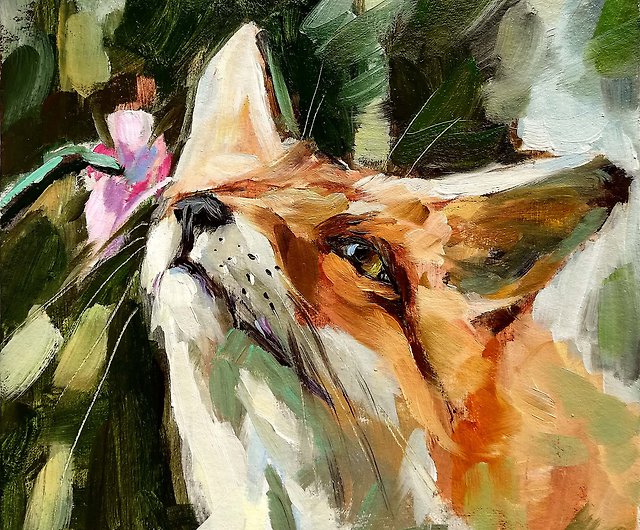Oil Paintings for Sale to Elevate Any Room
Oil Paintings for Sale to Elevate Any Room
Blog Article
Discovering Everything About Oil Paintings: A Guide to Understanding Their Charm and Worth
Oil paintings have captivated audiences for centuries, using a look right into the imaginative mastery of various eras. Their abundant history is intertwined with innovative techniques and profound psychological expression. Recognizing the materials and approaches behind these artworks can improve appreciation. Additionally, the market for oil paintings offers chances for financiers and collectors alike. As one explores this interesting globe, the question develops: what makes an oil paint truly useful?
The History of Oil Paint: A Journey Via Time
Oil paint has roots that date back to old times, it really grew during the Renaissance, when artists uncovered its adaptability and rich color potential. Early examples can be traced to the 7th century, with techniques progressing especially throughout cultures. The tool came to be prominent in Northern Europe in the 15th century, especially with the works of artists like Jan van Eyck, who spearheaded its usage for detailed realistic look and vibrant shades. This period marked a departure from tempera paints, enabling higher deepness and structure. As oil paint spread, it affected numerous artists, leading to masterpieces by prominent figures such as Leonardo da Vinci and Rembrandt. The tool's heritage continues, shaping the art globe well into modern-day times.
Recognizing Oil Paints: Products and Techniques
As musicians discover the globe of oil paints, they come across a varied range of materials and strategies that specify this medium. The key parts of oil paint consist of pigments, which provide shade, and drying oils, such as linseed, that bind the pigments and assist in application. Numerous additives can modify the paint's structure and drying time, boosting adaptability. Methods like glazing, where transparent layers are accumulated, and impasto, which entails using thick paint, enable various visual effects. Furthermore, making use of brushes, combination blades, and also fingers can produce distinct textures and coatings. Comprehending these techniques and products allows artists to totally share their creativity and attain the desired effect in their art work.
The Role of Color in Oil Paints
Color plays a pivotal role in oil paints, affecting both visual allure and psychological vibration. Comprehending shade theory fundamentals, consisting of the relationships in between tones, can enhance an artist's capacity to share state of mind and atmosphere. In addition, grasping color blending techniques enables for greater deepness and richness in a painting's palette.

Color Theory Basics
Recognizing shade concept is crucial for musicians functioning with oil paints, as it forms the structure for developing harmonious and visually interesting structures. Color theory encompasses the research of how shades interact, the shade wheel, and the connections between primary, additional, and tertiary colors. Artists utilize complementary shades to boost contrasts and produce focal points, while similar colors promote unity and cohesiveness within a piece. In addition, the concepts of cozy and amazing shades affect the perception of deepness and room in a painting. Understanding these concepts allows artists to control shade efficiently, directing the viewer's eye and interacting their designated message. Proficiency of color concept eventually improves a musician's capacity to share emotions and concepts through their work.
Emotional Impact of Color
The psychological effect of shade in oil paints plays an important function in exactly how customers connect and perceive with artwork. Shades evoke specific sensations and moods, affecting the visitor's mood. Warm tones like oranges and reds can create a sense of warmth and energy, while cool tones such as blues and environment-friendlies often evoke calmness or self-questioning. Artists strategically select shade schemes to enhance narrative elements, directing the audience's emotional trip. The saturation and comparison of colors better magnify these results, attracting focus and developing emphasis. Eventually, the interaction of shades in oil paints not just enhances their visual allure yet additionally serves as a powerful tool for psychological expression, improving the customer's experience and analysis.
Shade Mixing Techniques
While lots of facets of oil painting contribute to the general structure, mastering shade blending methods is vital for attaining wanted effects and depth. Shade blending can be come close to through different approaches, including the subtractive and additive processes. Additive blending includes combining shades of light, while subtractive mixing counts on pigments, where shades mix to produce new shades. Artists usually utilize a minimal scheme to produce unified jobs, understanding the relationships in between main, additional, and tertiary colors. Methods such as glazing and scumbling better boost deepness and brightness. By masterfully mixing shades, an artist can stimulate feelings, produce prime focus, and achieve a sense of realism, eventually raising the paint's emotional and visual effect.
Famous Oil Painters and Their Iconic Functions

Famed for their mastery of shade and strategy, oil painters have produced a few of one of the most popular art work in history. Distinguished artists like Vincent van Gogh mesmerized audiences with his stirring brushwork in "Starry Evening," while Claude Monet's "Perception, Dawn" prepared for Impressionism. Leonardo da Vinci's "Mona Lisa" remains a long-lasting sign of artistic genius, showcasing his ability in catching human expression. Rembrandt's "The Night Watch" highlights his cutting-edge use of light and shadow. Various other noteworthy figures consist of Pablo Picasso, who revolutionized contemporary art with his strong testing in works like "Les Demoiselles d'Avignon," and Georgia O'Keeffe, whose lively representations of landscapes and flowers aided specify American modernism. Each artist's unique style contributed substantially to the oil painting landscape.
How to Review the High Quality of an Oil Painting
Examining the high quality of an oil paint includes a cautious analysis of craftsmanship methods, along with an analysis of shade and make-up. Observing brushwork, layering, and the application of paint can expose the musician's skill degree. Additionally, the interplay of shades and the overall setup of aspects contribute significantly to the painting's aesthetic worth.
Assessing Workmanship Methods
A meticulous analysis of workmanship techniques is vital for figuring out the high quality of an oil painting. Evaluators need to initially check out the application of paint; thick, distinctive brushstrokes might recommend a skilled hand, while overly uniform applications could indicate an absence of depth. oil paintings for sale. The layering method is also essential; the visibility of lusters and varied density can enhance luminosity and intricacy. Furthermore, the top quality of the materials utilized, such as the canvas and pigments, plays a substantial function in toughness and overall visual. Focus to information in aspects like edges and shifts between shades mirrors the artist's dedication to their craft. Ultimately, these methods contribute to the painting's psychological influence and market price, offering as indicators of the musician's skill and intent
Examining Color and Make-up
While evaluating the quality of an oil paint, one need to focus on the interplay of shade and structure, as these elements are essential to the art work's general impact. Color choices can develop and evoke emotions state of mind; for that reason, the musician's combination should be checked out for consistency and contrast. A healthy make-up routes the viewer's eye and creates a sense of unity. Musicians commonly use techniques like the guideline of thirds or leading lines to improve visual interest. In addition, making use of light and darkness can include depth, improving the three-dimensionality of the painting. Inevitably, a successful oil painting marries color and make-up, involving the audience and inviting a deeper recognition of the artist's vision and method.
Caring for and Preserving Oil Paintings
Appropriate care and conservation of oil paints is important for preserving their honesty and longevity. To safeguard these artworks, it is essential to show them away from straight sunshine, which can cause fading and discoloration. Preserving a steady environment with controlled temperature level and humidity further help in protecting against damage. Cleaning up ought to be done gently making use of a soft, completely dry fabric, avoiding any type of harsh chemicals that could damage the paint or varnish. Routine examinations for indicators of wear and tear, such as cracking or flaking, are recommended. When delivering or storing oil paints, correct padding and framing are essential to stay clear of physical damage. Eventually, diligent care adds to the visual appeal and value of oil paints gradually.
The Marketplace for Oil Paints: Spending and gathering
Recognizing the marketplace characteristics for oil paintings is important for collectors and financiers alike. The worth of these art work is influenced by numerous elements, consisting of the musician's credibility, historic importance, and current trends. Enthusiasts commonly seek pieces that reverberate directly while considering potential gratitude in value. Galleries and public auctions act as primary places for buying and selling, with prices varying based on need and rarity. Purchasing oil paintings requires research study right into the market, as well as an understanding of authenticity and provenance. Furthermore, emerging musicians may provide chances for significant returns, while established names can regulate high costs. On the whole, a critical approach to accumulating can generate both visual pleasure and monetary incentives.

Regularly Asked Inquiries
What Are the Environmental Effects of Oil Paint Products?
The environmental influences of oil painting materials consist of the release of unpredictable natural compounds (VOCs), damaging waste generation, and resource removal for pigments. These elements contribute to pollution and ecological deterioration, raising issues amongst eco mindful artists and consumers.
Exactly How Do Different Canvases Affect Oil Paint Outcomes?
Different canvases affect oil painting results significantly. Surface, absorbency, and texture quality can alter paint application, drying out times, and shade vibrancy. Artists frequently select specific canvases to accomplish preferred effects and improve their imaginative expression.
Can Oil Paintings Be Recovered if Damaged?
If harmed, Oil paints can undoubtedly be restored. Professional conservators use various methods to repair rips, tidy surface areas, and address discoloration, ensuring that the artwork retains its initial elegance and worth for future generations.
What Are the Indicators of an Initial Oil Painting?
The indications of an original oil paint consist of visible brush strokes, appearance variants, and an uneven canvas weave (oil paintings for sale). Additionally, authenticity might be verified with provenance, signatures, and the visibility of a varnish layer one-of-a-kind to oil mediums
Just How Has Modern Technology Influenced Modern Oil Paint Techniques?
Modern technology has actually substantially influenced modern oil painting techniques by presenting digital devices for planning, enhanced products for texture and durability, and on the internet platforms for sharing and selling art, consequently broadening artists' creative opportunities and audience click here get to. Oil painting has origins that date back to ancient times, it truly grew throughout the Renaissance, when artists found its adaptability and abundant color capacity. The psychological influence of color in oil paintings plays an essential role in exactly how audiences regard and link with art work. While numerous facets of oil painting add to the total structure, mastering shade mixing methods is vital for accomplishing wanted impacts and depth. Assessing the top quality of an oil painting entails a cautious analysis of workmanship techniques, as well as an evaluation of color and composition. While assessing the quality of an oil painting, one must focus on the interplay of color and composition, as these aspects are essential to the art work's overall influence.
Report this page